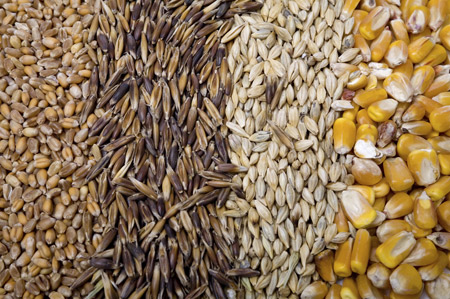Grains ease as key data loom. But soy rises
Category: Grains, Miscellaneous, Oilseeds
 (AgriMoney) – Last sessions before big events in agricultural commodities can often bring a touch of profit-taking.
(AgriMoney) – Last sessions before big events in agricultural commodities can often bring a touch of profit-taking.
And that was the way it looked on Friday, as corn and, especially, wheat gave up some ground regained in the last session.
The big event is, of course, Monday’s US Department of Agriculture double bill of major reports, one on acreage prospects for US crops, and the other on domestic stocks as of March 1, giving an important insight into demand.
The quarterly stocks reports, in particular, have a habit of causing major price swings.
Crimea tensions ease
As another reason for weaker grain prices, tensions over the Crimea crisis appear to have edged back a touch.
While US President Barack Obama on Wednesday warned of more sanctions against Moscow “unless Russia alters its course”, German chancellor Angela Merkel, closer to the action took a more conciliatory line.
She said she was “not interested in escalation” of tension with Russia and that the West “has not reached a stage that implies the imposition of economic sanctions”.
Concerns that the Ukraine crisis will interrupt shipments in the third-ranked corn exporting country and sixth-ranked wheat exporter, or hamper funds for spring plantings, have been a big prop to grain values.
Weather worries
Not that all worries are over for grain buyers, with dryness still a threat to winter wheat seedlings, and cold soil temperatures a concern as the spring sowings window for the likes of corn opens up.
Forecasts for the drought-hit southern Plains hard red winter wheat country show that “temperatures warm up this weekend, with the next shot of rain in the cards for early next week,” said Jonathan Watters at Benson Quinn Commodities.
Like the showers earlier this week, rain “totals aren’t expected to be high and the driest areas of the panhandle/western Kansas won’t be the focus”.
Furthermore, there are a few weather worries elsewhere too, such as dryness in eastern Europe and in eastern Australia, and some concerns in the former Soviet Union too.
“Cold temperatures are scheduled to hit southern Russia later this week, while major growing areas in Ukraine haven’t seen rain in months,” Mr Watters said.
Hedge fund positioning
However, hedge funds have already placed big bets on rising crop prices.
Updated data will be released late today. But the last batch showed hedge funds net long 24,000 contracts in Chicago wheat, a hefty reversal from a net short of more than 60,000 contracts at the end of January.
In Chicago corn futures and options, they have turned from a net short of 50,000 contracts to a net long of nearly 228,000 lots.
Chicago wheat for May stood 0.6% lower at $7.06 a bushel as of 08:45 UK time (04:45 Chicago time), while corn for May was down 0.4% at $4.90 ¼ a bushel.
Bouncing beans
And that was, ironically, a bit of help for soybeans, with investors appearing keen on spreading the oilseed against grains.
Soybeans’ decline in the last session was attributed in part to short soybean-long corn bets, some of which may be being unwound for a quick turn.
Furthermore, soyoil was providing some help to the complex too, with a 0.7% rise to 40.71 cents a pound, although spreading was again seen as a factor here, with the vegetable oil paired off against soymeal.
Soymeal indeed edged $0.20 lower to $470.30 a short ton.
Crude oil support
Soyoil also received a bit of help from rival vegetable oil palm oil, which added 0.2% to 2,659 ringgit a tonne, bouncing off it 100-day moving average, on a continuous chart, as it did in January and (just about) February too.
Besides bargain hunting, after a decline from highs at 2,916 ringgit a tonne three weeks ago, palm oil has been helped by higher crude oil prices, important given that the vegetable oil is largely used in making biofuels.
“Recent high energy prices would encourage the use of biodiesel, hence garnering some support for palm oil,” Phillip Futures said.
Mixed prices
Soybeans themselves for May added 0.2% to $14.39 ½ a bushel.
This despite a fall in prices on the Dalian exchange in China, the top importing country of the oilseed, where September soybeans eased 0.5% to 4,322 yuan a tonne.
September soymeal dropped 0.6% to 3,382 yuan a tonne on the Dalian.
And there remain plenty of worries over Chinese buyers cancelling orders, in the face of domestic demand for soymeal softened by the bird flu outbreak.
Data later
“There is talk that Chinese crushers continue to try to cancel Brazilian soybean sales with potential problems related to credit being cited,” Benson Quinn Commodities said, adding that “port supplies remain ample and their crush margins have not improved”.
Furthermore, with Brazilian prices having a “weaker tone, the possibility of US importing more soybeans and/or soymeal is real”, a factor which would weigh on prices of domestic supplies.
South America, and in particular Argentina, is likely to come into focus later when the country’s farm ministry unveils its first estimate for the domestic soybean crop, pegged by traders at about 54m tonnes, a record high.
After the close of play, the USDA will also reveal data key to feed markets, in the quarterly hogs report, which will give an insight into the impact of porcine epidemic diahorrea virus (PEDv) on the US herd.




